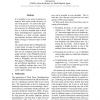Free Online Productivity Tools
i2Speak
i2Symbol
i2OCR
iTex2Img
iWeb2Print
iWeb2Shot
i2Type
iPdf2Split
iPdf2Merge
i2Bopomofo
i2Arabic
i2Style
i2Image
i2PDF
iLatex2Rtf
Sci2ools
ACL
2010
2010
Wikipedia as Sense Inventory to Improve Diversity in Web Search Results
Is it possible to use sense inventories to improve Web search results diversity for one word queries? To answer this question, we focus on two broad-coverage lexical resources of a different nature: WordNet, as a de-facto standard used in Word Sense Disambiguation experiments; and Wikipedia, as a large coverage, updated encyclopaedic resource which may have a better coverage of relevant senses in Web pages. Our results indicate that (i) Wikipedia has a much better coverage of search results, (ii) the distribution of senses in search results can be estimated using the internal graph structure of the Wikipedia and the relative number of visits received by each sense in Wikipedia, and (iii) associating Web pages to Wikipedia senses with simple and efficient algorithms, we can produce modified rankings that cover 70% more Wikipedia senses than the original search engine rankings. 1 Motivation The application of Word Sense Disambiguation (WSD) to Information Retrieval (IR) has been subject...
| Added | 10 Feb 2011 |
| Updated | 10 Feb 2011 |
| Type | Journal |
| Year | 2010 |
| Where | ACL |
| Authors | Celina Santamaría, Julio Gonzalo, Javier Artiles |
Comments (0)

